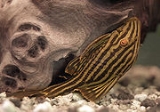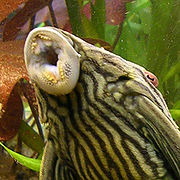
Royal plec
Encyclopedia
The royal plec, royal pleco, or royal panaque, Panaque nigrolineatus, is a herbivorous freshwater catfish
from South America
known for being one of the few fish that digest wood. It is the type species
of its genus
and a member of the Loricariidae
. In its native habitat this fish is eaten as food. This fish is also a popular aquarium fish.
 The royal plec is closely related to the popular plecostomus
The royal plec is closely related to the popular plecostomus
catfish kept in many aquaria as an algae
eater. While the royal plec also eats algae, it is best known among biologists as being among the very few fish capable of eating and digesting wood
. It does so using symbiotic gut bacteria. Royal plecs are light grey in colour patterned with dark grey squiggles. They have red eyes and the dorsal fins are edged with cream or gold. The body is encased in heavy armour, except for the belly, which is soft. This armour is made of strong plates of skin, not scales. Royal plecs can grow to 43 centimetres (17 in) in length. Because they are heavy and inflexible, they do not swim well, but they do have a strong sucker-like mouth that enables them to hold onto rocks and wood in fast flowing waters.
.
, with the fish needing plenty of space, well oxygenated water, and a regular supply of vegetables and wood on which to feed. Young are often imported in an undernourished state which requires dedicated attention to allow recovery. Primarily nocturnal, this fish is generally shy under the light and will keep in hiding during the day. This fish is territorial, so a suitable resting area for this fish is necessary. This species has not yet been bred in captivity.
Catfish
Catfishes are a diverse group of ray-finned fish. Named for their prominent barbels, which resemble a cat's whiskers, catfish range in size and behavior from the heaviest and longest, the Mekong giant catfish from Southeast Asia and the second longest, the wels catfish of Eurasia, to detritivores...
from South America
South America
South America is a continent situated in the Western Hemisphere, mostly in the Southern Hemisphere, with a relatively small portion in the Northern Hemisphere. The continent is also considered a subcontinent of the Americas. It is bordered on the west by the Pacific Ocean and on the north and east...
known for being one of the few fish that digest wood. It is the type species
Type species
In biological nomenclature, a type species is both a concept and a practical system which is used in the classification and nomenclature of animals and plants. The value of a "type species" lies in the fact that it makes clear what is meant by a particular genus name. A type species is the species...
of its genus
Genus
In biology, a genus is a low-level taxonomic rank used in the biological classification of living and fossil organisms, which is an example of definition by genus and differentia...
and a member of the Loricariidae
Loricariidae
Loricariidae is the largest family of catfish , with almost 700 species and new species being described each year. Loricariids originate from fresh water habitats of Costa Rica, Panama, and tropical and subtropical South America. These fish are noted for the bony plates covering their bodies and...
. In its native habitat this fish is eaten as food. This fish is also a popular aquarium fish.
Anatomy and appearance

Plecostomus
Hypostomus plecostomus is the scientific name for a type of freshwater tropical Central and South American fish belonging to the family Loricariidae. They are large algae eaters, and to differentiate them from small algae eaters, they are often referred to as plecostomus, often abbreviated as...
catfish kept in many aquaria as an algae
Algae
Algae are a large and diverse group of simple, typically autotrophic organisms, ranging from unicellular to multicellular forms, such as the giant kelps that grow to 65 meters in length. They are photosynthetic like plants, and "simple" because their tissues are not organized into the many...
eater. While the royal plec also eats algae, it is best known among biologists as being among the very few fish capable of eating and digesting wood
Wood
Wood is a hard, fibrous tissue found in many trees. It has been used for hundreds of thousands of years for both fuel and as a construction material. It is an organic material, a natural composite of cellulose fibers embedded in a matrix of lignin which resists compression...
. It does so using symbiotic gut bacteria. Royal plecs are light grey in colour patterned with dark grey squiggles. They have red eyes and the dorsal fins are edged with cream or gold. The body is encased in heavy armour, except for the belly, which is soft. This armour is made of strong plates of skin, not scales. Royal plecs can grow to 43 centimetres (17 in) in length. Because they are heavy and inflexible, they do not swim well, but they do have a strong sucker-like mouth that enables them to hold onto rocks and wood in fast flowing waters.
Distribution and habitat
The royal plec can be found in the Orinoco River as well as a number of tributaries of the Amazon RiverAmazon River
The Amazon of South America is the second longest river in the world and by far the largest by waterflow with an average discharge greater than the next seven largest rivers combined...
.
Varieties
There are several undescribed varieties of Panaque that are very similar to Panaque nigrolineatus and are commonly traded as aquarium fish http://www.planetcatfish.com/catelog/genus.php?genus_id=27#151. These may be regional variations, subspecies, or closely related species. All share the same basic colouration but vary in the shape and distribution of the stripes and the amount of cream or gold on the fins. These varieties are:- Panaque sp. cf. nigrolineatus 'Tapajos' (after the river from which it is collected)
- Panaque sp. cf. nigrolineatus 'watermelon pleco'
- Panaque sp. cf. nigrolineatus 'olive pleco'
- Panaque sp. cf. nigrolineatus 'Tocantins' (after the riverTocantins RiverThe Tocantins is a river in Brazil, the central fluvial artery of the country. In the Tupi language, its name means "toucan's beak" . It runs from south to north for about 2,640 km. It is not really a branch of the Amazon River, although usually so considered, since its waters flow into the...
from which it is collected) - Panaque sp. cf. nigrolineatus 'Xingu' (after the riverXingu RiverThe Xingu River , also called Rio Xingu, is a 1,230-mile long, river in north Brazil; it is a southeast tributary of the Amazon River.-Description and history:...
from which it is collected)
In the aquarium
The Royal plec is valuable as an aquarium fish. It is a very attractive aquarium fish which grows to a large size. Maintenance is as for other PanaquePanaque
The genus Panaque contains a small number of small to medium sized South American armoured catfishes that are notable for being among the very few vertebrates that feed extensively on wood. In addition, algae and aufwuchs are an important part of the diet, and they use their rasping teeth to...
, with the fish needing plenty of space, well oxygenated water, and a regular supply of vegetables and wood on which to feed. Young are often imported in an undernourished state which requires dedicated attention to allow recovery. Primarily nocturnal, this fish is generally shy under the light and will keep in hiding during the day. This fish is territorial, so a suitable resting area for this fish is necessary. This species has not yet been bred in captivity.

